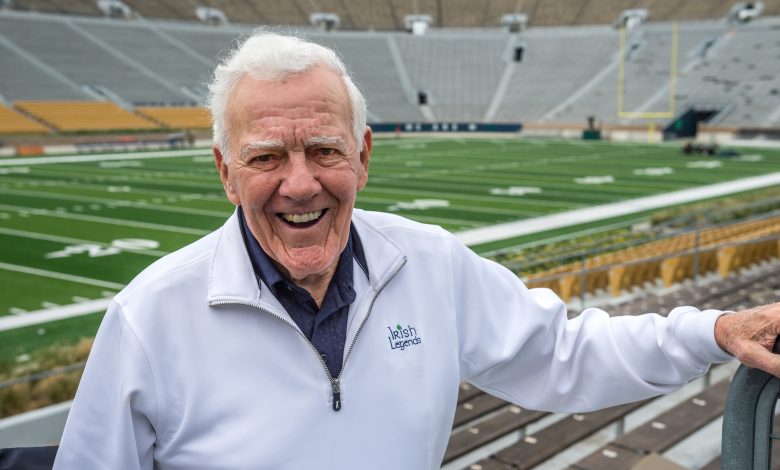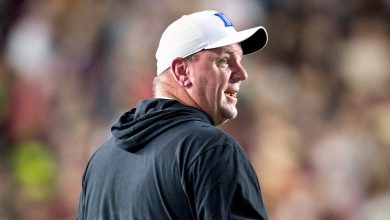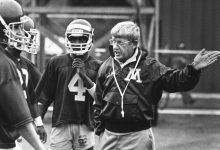Former Notre Dame coach Ara Parseghian dies at 94, A Deep dive into his time as Notre Dame coach

The passing of Coach Ara Parseghian at the age of 94 marks the end of an era in Notre Dame football. As one of the most revered figures in the history of college football, Parseghian’s impact on the Fighting Irish and the sport as a whole is immeasurable. His tenure at Notre Dame was defined not only by victories and championships but by the way he transformed the culture of the team and the program. A deep dive into his time as Notre Dame’s head coach reveals not only the accomplishments of a football genius but also the story of a man whose influence extended far beyond the field.
Ara Parseghian’s journey to Notre Dame began in the early 1960s, at a time when the storied program was struggling to regain its former glory. While Notre Dame was synonymous with college football excellence, the team had been in a bit of a slump in the decade following the departure of legendary coach Frank Leahy in 1953. Despite flashes of brilliance, the Irish had failed to secure a national championship since Leahy’s last title in 1949. The program was at a crossroads.
In 1964, when Notre Dame came calling, Parseghian was already an established name in the world of college football. Prior to his arrival in South Bend, he had built a successful coaching career at Northwestern University, where he had gained a reputation for turning around a floundering program. Despite competing in the tough Big Ten, Parseghian led Northwestern to a series of solid seasons, including an appearance in the Rose Bowl in 1959.
It was Parseghian’s work at Northwestern that attracted the attention of Notre Dame’s athletic director, Edward “Moose” Krause. Krause had a vision to bring the Fighting Irish back to prominence, and he believed Parseghian was the man who could do it. The 41-year-old coach, who had demonstrated a keen strategic mind and a remarkable ability to motivate his players, took the job with the weight of Notre Dame’s expectations on his shoulders.
When Ara Parseghian was hired as head coach of Notre Dame in 1964, he inherited a program that had seen a steady decline in recent years. The Irish had finished with a losing record in three of the previous five seasons, and the gap between Notre Dame and the nation’s elite programs had widened. Nonetheless, Parseghian was undeterred. He arrived in South Bend with a calm, confident demeanor and a no-nonsense approach to building the program.
One of the first things Parseghian did was change the culture of the Notre Dame football program. He brought in a new style of coaching—one that emphasized discipline, teamwork, and a strong work ethic. His focus was on building a cohesive unit, where each player understood their role and was willing to put the team above individual achievement. Parseghian often spoke about the importance of selflessness and how every player on the field had to be dedicated to the greater good of the team.
“Football is not about individual glory,” Parseghian would often say. “It’s about the collective effort. When you play as a team, you can accomplish anything.”
His commitment to teamwork and discipline soon began to pay dividends. In his first season, Notre Dame finished with an 8–2 record, a remarkable improvement over the previous years. The Irish had a strong defense, a powerful running game, and a quarterback, Bob Williams, who was quickly becoming one of the best in the nation. But it wasn’t just the talent on the field that stood out—it was the way the team played together.
In his second season, Parseghian’s Notre Dame team took another giant step forward, finishing the 1965 season with an undefeated record of 9–0–1. The lone tie came in a thrilling game against the University of Southern California, and the Irish’s strong finish put them on the map as a national contender. While the 1965 season did not result in a national championship, it was clear that Parseghian had begun to instill a winning mentality within the program.
The breakthrough came in 1966. With a team brimming with talent on both sides of the ball, Parseghian led Notre Dame to a perfect 9–0 record during the regular season. In the process, the Irish knocked off some of the toughest teams in the nation, including a dominant win over the University of Michigan. But it was the final game of the regular season—an epic showdown with the University of Southern California—that would solidify Notre Dame’s place in college football history.
The game against USC was a tense, high-stakes affair. The Trojans, led by coach John McKay, were one of the best teams in the country, and many believed that they would finally get the best of the Irish. But Parseghian’s team, led by star running back Nick Eddy and quarterback Coley O’Brien, executed a game plan that would ultimately deliver a 51–0 victory. The win secured Notre Dame’s place in the 1967 Rose Bowl, where they faced the University of Michigan State in a game that would determine the national champion.
The Rose Bowl was a spectacle of defensive prowess. Despite facing a Michigan State team that featured future NFL stars like George Webster and Clinton Jones, Parseghian’s defense held firm. The Irish offense, led by the running of Eddy and O’Brien’s timely passing, took control early and never looked back. The final score was a 14–10 Notre Dame victory, securing Ara Parseghian’s first national championship in just his third season at the helm.
The 1966 national championship was a crowning achievement not only for Parseghian but for the entire Notre Dame program. It was a statement that Notre Dame was back on top, and Ara Parseghian was the man who had revitalized the program. The championship win marked the beginning of an era of sustained success for Notre Dame football.
In 1967, Parseghian’s team returned to the Rose Bowl to defend their title, but this time, they were unable to replicate their earlier success, losing to the University of Southern California. Despite the setback, the Fighting Irish continued to remain among the top teams in the nation under Parseghian’s guidance. Over the next several seasons, Notre Dame would remain a constant contender, with Parseghian’s leadership taking the team to several major bowl games.
However, it was not just his on-field success that made Parseghian an icon. His calm, measured demeanor and his ability to navigate the often-turbulent waters of college football made him a beloved figure in the Notre Dame community. He was known for his integrity, his humility, and his commitment to the ideals of Notre Dame. Parseghian’s approach to coaching was grounded in the values of discipline, hard work, and respect, and he instilled these values in every player who wore the Fighting Irish uniform.
In addition to his coaching prowess, Ara Parseghian became a role model for many of his players. He was not just a coach to them; he was a mentor, a father figure, and someone they could always turn to for advice. His ability to form deep, personal relationships with his players set him apart from many of his contemporaries.
Throughout his tenure at Notre Dame, Parseghian consistently attracted top-tier talent. Players like quarterback Joe Theismann, running back John Huarte, and linebacker Willie Townes all thrived under his tutelage. But despite having future NFL stars on his teams, Parseghian always emphasized that it was the collective effort of the team that led to success. It was his belief that the team as a whole was greater than the sum of its parts—a mindset that permeated the program.
Despite stepping away from coaching in 1974 after ten successful seasons, Parseghian’s legacy continued to influence the Notre Dame program long after his departure. He would remain a fixture at the university, a revered figure whose contributions to the sport were undeniable. Following his retirement, he went on to have a successful career in television, serving as a color commentator for college football games, where his insights and deep knowledge of the game made him a respected voice in broadcasting.
Ara Parseghian’s impact on Notre Dame football and college football in general cannot be overstated. His success on the field—culminating in two national championships (1966 and 1973)—was a testament to his ability to lead and inspire. But perhaps his most enduring legacy is the culture he built at Notre Dame. Under his leadership, Notre Dame once again became synonymous with excellence, integrity, and discipline, values that would continue to guide the program for decades.
As the years passed, Parseghian remained a beloved figure at Notre Dame. His name became synonymous with success, and his influence could be seen in the way the university continued to approach football. Coaches who followed him—such as Lou Holtz, Bob Davie, and Brian Kelly—would all build upon the foundation that Parseghian had established. But it was his calm presence, his dedication to developing not just great football players but great people, that set him apart.
The passing of Ara Parseghian leaves a void in the world of college football, but his legacy will never fade. He will forever be remembered not only for the victories he achieved but for the way he shaped the Notre Dame football program and the countless young men who played for him. A true legend of the game, Ara Parseghian’s impact on the sport will be felt for generations to come.









